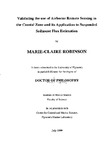Validating the use of Airborne Remote Sensing in the Coastal Zone and its Application to Suspended Sediment Flux Estimation
| dc.contributor.author | ROBINSON, MARIE-CLAIRE | |
| dc.contributor.other | School of Biological and Marine Sciences | en_US |
| dc.date.accessioned | 2013-09-24T11:47:46Z | |
| dc.date.available | 2013-09-24T11:47:46Z | |
| dc.date.issued | 1999 | |
| dc.identifier | NOT AVAILABLE | en_US |
| dc.identifier.uri | http://hdl.handle.net/10026.1/1930 | |
| dc.description.abstract |
Coastal and estuarine environments are dynamic yet highly sensitive which makes them particularly susceptible to any changes dictated by external forces. The interaction between environmental forces and those imposed by humans who live and work in the area is a very delicate one and needs to be considered through an holistic management approach to ensure the maintenance of a sustainable equilibrium. The use of airborne remote sensing in the coastal zone has been employed and validated for the specific aims of suspended particulate matter (SPM) concentration and flux quantification in the Humber Estuary and sea-surface temperature and salinity determination in the Tweed Estuary. Routines for the effective radiometric, atmospheric, thermal and geometric correction of Compact Airborne Spectrographic Imager (CASQ and Airborne Thematic Matter (ATM) data were tested and enhanced. Validations at all stages were executed through comparison with sea-based optical data acquired coincident with the images. The data acquired from the sea-surface also yielded important information regarding the nature and content of the waters. Water classification techniques were addressed and a new algorithm for use in case II waters based on the Austin & Petzold (1981) K^{490) routine derived. A new algorithm to determine SPM concentration in the Humber Estuary from CASI images was successfully determined and validated. SPM flux estimates were ascertained through the incorporation of image data, hydrodynamic models and depth profiles determined from hydrographic charts. In the Tweed Estuary, ATM images were used to determine sea-surface temperature and salinity using thermal image calibration and comparison with surface monitoring. The results provide an hitherto unseen insight into the dynamics of the Humber and the Tweed Estuaries. In particular, information regarding SPM concentration and fluxes in the Humber supports the so far unproved hypothesis that most of the SPM moves into and out of the mouth in elongated streaks. The use of the width of a streak (or patch) to predict the SPM concentration and / or flux and so eliminate the necessity for surface-based monitoring was addressed. Algorithms to determine SPM concentration and flux were devised using patch size and within-patch water depth alone. A model to apply these algorithms to all data was unsuccessful due to the sparse temporal coverage of the image data. The analyses exemplified in this study give an invaluable insight into the forces at play in coastal and estuarine environments and would provide key information sources for hydrodynamic modellers and coastal zone managers. | en_US |
| dc.description.sponsorship | Centre for Coastal and Marine Science, Plymouth Marine Laboratory | en_US |
| dc.language.iso | en | en_US |
| dc.publisher | University of Plymouth | en_US |
| dc.title | Validating the use of Airborne Remote Sensing in the Coastal Zone and its Application to Suspended Sediment Flux Estimation | en_US |
| dc.type | Thesis | |
| plymouth.version | Full version | en_US |
| dc.identifier.doi | http://dx.doi.org/10.24382/4698 | |
| dc.identifier.doi | http://dx.doi.org/10.24382/4698 |
Files in this item
This item appears in the following Collection(s)
-
01 Research Theses Main Collection
Research Theses Main


